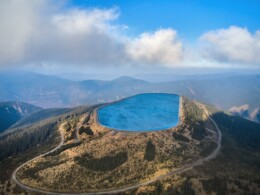A new initiative from Central West Media
Over the coming months we will be exploring in depth the subject of Energy Transition and how it affects the Central West, particularly in Lithgow, Oberon, Bathurst and Blayney.
There are a variety of new and rapidly improving technologies shaping the future of energy in this country, however lack of information and community sentiment is seeing the regions foundational stake in the energy sector being challenged.
Our aim is to inform our readers, paint the picture as it really is and give options for education and conversation in this arena, ensuring that whatever Australia’s energy needs are into the future, our communities are part of that plan, whilst also diversifying our economies into more sustainable long term industries.
Australia’s shift towards renewable energy is bringing profound changes to the regions that have long relied on coal, and few places are feeling the impact more keenly than the Central West. This area, which includes communities such as Lithgow have a deep-rooted connection to coal mining and coal-fired power generation, providing stable jobs and supporting local economies for decades. As the country accelerates its transition away from coal, these towns face a future where the decline of traditional industries must be balanced with new opportunities in renewable energy.
The push towards renewable energy, driven by Australia’s net-zero emissions target and the growing competitiveness of wind and solar power, is reshaping the nation’s energy landscape. For communities that have built their economies around coal, this shift signals the end of an era. Lithgow, with its Mount Piper Power Station, has long been a hub for coal-fired electricity production, while Oberon and Blayney have historically benefitted from the associated economic activities. The closure of coal plants and the reduction of mining operations present significant challenges for these areas, where the loss of coal-related jobs could lead to economic hardship and social disruption.
In towns like Lithgow, where coal mining has provided livelihoods for generations, the potential loss of stable, well-paying jobs is a pressing concern. The projected closure of Mount Piper Power Station, expected within the next decade, could mean job losses not only at the plant but also across supply chains, including local businesses that provide goods and services to the coal industry. The impact is likely to extend beyond direct employment, affecting the economic fabric of communities as consumer spending declines and young workers migrate elsewhere for better prospects.
The social consequences of this energy transition are also significant. The sense of identity and heritage tied to coal mining runs deep in places like Lithgow and the surrounding areas. As coal jobs disappear, there is a risk of losing more than just economic stability; the cultural fabric of these towns may fray, with social challenges arising as a result. The mental health implications of job losses, combined with concerns over economic inequality, present complex issues that need to be addressed with sensitivity and foresight.
Renewable energy projects are already starting to reshape the region’s landscape, with solar farms and wind turbines gradually becoming a common sight. In Oberon, efforts to diversify the local economy could be further supported by these projects, providing new employment opportunities and stimulating investment. There is however a section of the community against the proposed projects, fearing it will negatively impact their lifestyle and the place they call home. However, the shift away from coal could also bring environmental benefits, including improved air quality and reduced greenhouse gas emissions, which would contribute to better public health outcomes for the local region.
For affected workers, the transition to renewables presents both challenges and opportunities. Retraining and reskilling programs are being developed to help former coal workers acquire the skills needed for new roles in the renewable energy sector. These initiatives aim to ensure that the shift towards cleaner energy sources is managed in a way that supports those most affected by the closure of traditional industries. The success of such programs will be crucial in determining whether communities like Lithgow and Oberon can emerge stronger and more resilient in the face of change.
Concerns remain about the pace of the transition and whether it will be managed equitably. Some community members worry about a lack of clarity regarding the timelines for coal plant closures and the availability of alternative employment options. If the transition is not carefully managed, it risks exacerbating existing social inequalities and leaving vulnerable populations behind. There are calls for stronger government policies to ensure that the benefits of renewable energy development are distributed fairly, with priority given to workers from coal-dependent towns for new job opportunities.
Upgrading the region’s infrastructure to support the increased reliance on renewable energy is another crucial aspect of the transition. Projects like the Central-West Orana transmission line will be essential for integrating the new sources of energy into the grid and ensuring that the power generated from wind and solar projects can be delivered to demand centres across New South Wales. These infrastructure investments will not only support the energy transition but also provide long-term economic benefits, potentially boosting other industries in the area, such as agriculture and manufacturing, which require reliable and affordable electricity.
In the face of uncertainty, some optimism prevails. Many locals recognise that the shift towards renewable energy, while challenging, could ultimately breathe new life into the region. By embracing the potential of clean energy and working to diversify the economy, the Central West could emerge as a leader in Australia’s renewable energy future. For communities like Lithgow, Oberon, and Blayney, this moment presents an opportunity to redefine their economic identities and build a sustainable path forward.
As the dust begins to settle on the era of coal, the future of the Central West will depend on the strength of the policies implemented today. A “just transition” – one that prioritises support for workers and communities most affected by change – will be essential to ensuring that the region can adapt and thrive.
By investing in social infrastructure, reskilling programs, and renewable energy development, the Central West can navigate the challenges of the energy transition and emerge as a region of opportunity and innovation.
Whilst not everybody agrees on what that energy transition looks like, our goal is to ensure a technology agnostic and impartial view of the possible technologies and give our readers the opportunity to make their own decisions about what they are most comfortable with, and in the process hopeful elevate the conversation and debate as the transition accelerates.










